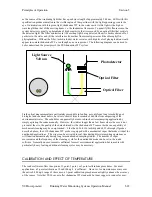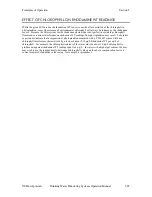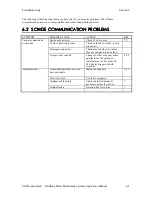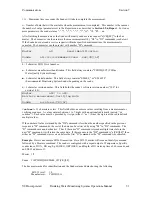
Principles of Operation
Section 5
YSI Incorporated Drinking Water Monitoring Systems Operation Manual
5-21
INTERFERENCES FROM OTHER FLUORESCENT SPECIES:
The analytical methods described in
Standard Methods
for chlorophyll involve disruption of the living organisms present in suspension,
followed by extraction of molecular chlorophyll into a homogeneous solution in an organic solvent.
Acidification of the extract helps to minimize the interferences caused by a number of other, non-
chlorophyll species. In addition, readings can be taken at various wavelengths on a spectrophotometer to
differentiate between the various forms of chlorophyll (a, b, c) and pheophytin a.
In contrast to this fairly controlled situation, all
in vivo
sensors operate under whole-cell, heterogeneous
conditions where the sensor will measure, at least to some degree, everything which fluoresces in the
region of the spectrum above 630 nm when irradiated with 470 nm light. Therefore, the sensor is really
quantifying overall fluorescence under these optical conditions, rather than chlorophyll specifically. While
it is probable that most of the fluorescence is due to suspended plant and algal matter and that much of the
fluorescence from this biomass is due to chlorophyll, it is impossible to exclude interferences from other
fluorescent species using the approach described above.
Note that
in vivo
fluorometers usually cannot differentiate between the different forms of chlorophyll.
LACK OF CALIBRATION REAGENTS:
The usual reagents which are used for the calibration of
fluorometric measurements for chlorophyll after extraction into organic solvents are purchased as “purified
chlorophyll a” from chemical supply vendors such as Sigma. These standards are not soluble in aqueous
media and, even if they were, their fluorescence is unlikely to be the same as when the chlorophyll is
present in the whole living cell. Therefore, for even a semiquantitative calibration, the user needs a
“substitute” standard such as Acridine Orange (see above) to provide a method for estimating the
sensitivity of the sensor. Field readings based on this type of calibration will provide only an estimate of
chlorophyll in environmental water where the measurement is taken on whole cell suspensions
in vivo
. The
calibration standard that provides the best measure of accuracy for
in vivo
chlorophyll sensors is a portion
of a phytoplankton suspension that has been analyzed for chlorophyll by the extractive procedure. We
recommend the use of this procedure and further recommend that the phytoplankton suspension be taken
from the site being monitored so that the species producing the fluorescence in the standard are as close as
possible to the field organisms. To truly assess data reliability in a long term monitoring study, grab
samples should be taken periodically, e.g. weekly, and analyzed in the laboratory as the study progresses.
These data can then be used to “postcalibrate” the readings logged to the instrument during the study,
perhaps using a spreadsheet for the simple mathematical treatment. In any case, getting quantitative
chlorophyll data from any
in vivo
fluorometric sensor is much more difficult than with most other
environmental sensors. For this reason, it is difficult to provide an accuracy specification for chlorophyll
measurement made with
in vivo
fluorometers and therefore no accuracy specification is quoted for the YSI
6025.
EFFECT OF CELL STRUCTURE, PARTICLE SIZE, AND ORGANISM TYPE ON
IN VIVO
READINGS:
Even if the only fluorescent species present for
in vivo
measurements were chlorophyll, and
reliable calibration standards were available, its absolute quantification would probably still be difficult
because samples are not homogeneous. Differing species of algae with differing shape and size will likely
fluoresce differently even if the type and concentration of chlorophyll are identical and this significantly
limits the accuracy of
in vivo
measurements.
EFFECT OF TEMPERATURE ON PHYTOPLANKTON FLUORESCENCE: As
noted above, YSI
experiments indicate that phytoplankton fluorescence increases as temperature decreases. Thus, readings
taken on a phytoplankton suspension at cold temperature would erroneously indicate the presence of more
phytoplankton than when the suspension is read at room temperature. Unless this effect is taken into
account, most field readings will be somewhat in error, since the field temperature will differ from the
temperature of calibration. The use of the “Chl Tempco” factor found in the Advanced|Sensor menu will
help to reduce this error, but must be used with caution since each species of phytoplankton is likely to
have a slightly different temperature dependence.
EFFECT OF LIGHT ON PHYTOPLANKTON FLUORESCENCE:
It is well documented in the
literature that the fluorescence of chlorophyll resident in phytoplankton can be inhibited by light. This
Содержание 600DW-B
Страница 3: ......
Страница 239: ...Principles of Operation Section 5 YSI Incorporated Drinking Water Monitoring Systems Operation Manual 5 26...
Страница 251: ...Warranty and Service Information Section 8 YSI Incorporated Drinking Water Monitoring Systems Operations Manual 8 4...
Страница 259: ...Required Notice Appendix B YSI Incorporated Drinking Water Monitoring Systems Operations Manual B 2...
Страница 264: ...EMC Performance Appendix D YSI Incorporated Drinking Water Monitoring Systems Operations Manual D 2...
Страница 268: ...Specifications Appendix E YSI Incorporated Drinking Water Monitoring Systems Operations Manual E 4...
Страница 297: ......
















































